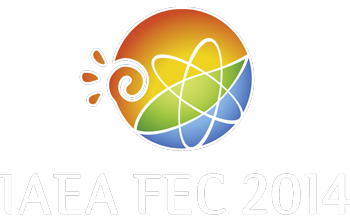Speaker
Dr
Francesca Turco
(Columbia University)
Description
Modeling results, obtained with the full kinetic MARS-K code [1] for a set of DIII-D experimental equilibria, predict that the absence of fast beam generated ions in ITER will lead to a plasma response ~40% higher than in the present NBI-sustained H-mode plasmas. It has been postulated that the presence of fast ions may have a stabilizing effect on the RWM that would account for its observed stability, specifically in the DIII-D tokamak (the fast-ion generating Neutral Beam Injection system is the main heating system DIII-D plasmas). These dependencies may extrapolate unfavourably to machines with significantly smaller fractions of fast ions such as ITER. Elevated plasma response values will likely cause the potential onset of a resistive wall mode (RWM) instability. If the RWM is destabilized, operation above the no-wall limit will likely require a set of coils and a feedback system capable of detecting and stabilizing the external kink instability on the wall-time scale (~2.5 ms in DIII-D). Active MHD spectroscopy can be used to indicate the approach to pressure driven MHD limits. This technique can define when the RWM feedback is needed and ultimately help to avoid disruptions. The MHD spectroscopy system reacts differently in the case of current driven instabilities. The plasma response amplitude in these cases remains low up to ~93% of the limit, showing an abrupt increase only in the last ~5% of the current ramp, making it much less effective as a warning system. However, new modelling shows that the mode structure of the current driven RWM is very close to that of the pressure driven case, as measured in DIII-D plasmas with q_{edge}~2 and modelled with the MARS-F and MARS-K codes. These equilibria, which show a hard disruptive limit when qedge crosses 2, were used to develop an RWM feedback system that allowed to cross the q=2 limit and sustain the plasma at q~1.9 for ~400 wall times [2].
[1] Y. Liu, Phys. Plasmas 15, 092505 (2008)
[2] J.M. Hanson, et al, Bulletin of the American Physical Society, Division of Plasma Physics 58, TI2.00003 (2013).
Work supported in part by the US DOE under DE-FG02-04ER54761, DE-AC02-09CH11466 and DE-FC02-04ER54698.
| Country or International Organisation | USA |
|---|---|
| Paper Number | EX/P2-20 |
Author
Dr
Francesca Turco
(Columbia University)
Co-authors
Dr
Alan D. Turnbull
(General Atomics)
Prof.
Gerald A. Navratil
(Columbia University)
Dr
Jeremy Hanson
(Columbia University)
Dr
Matthew J. Lanctot
(General Atomics)

